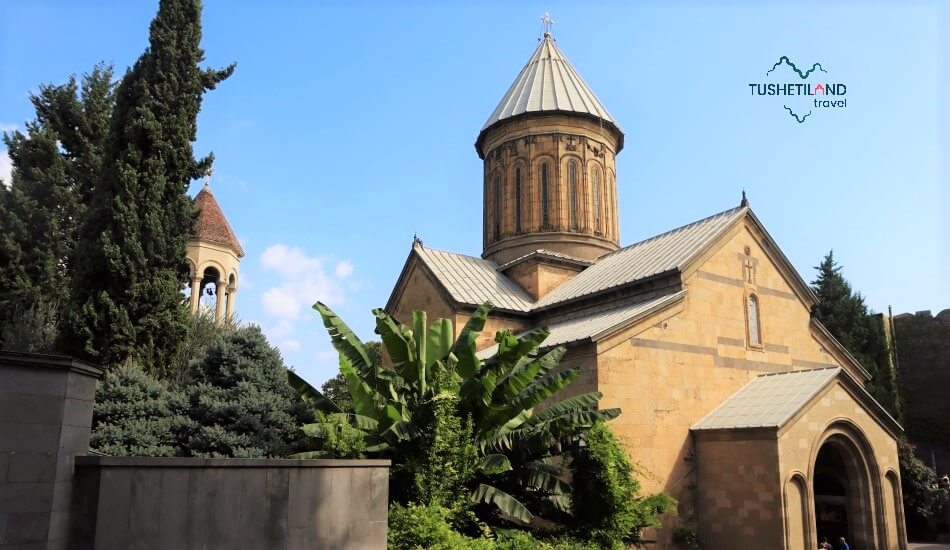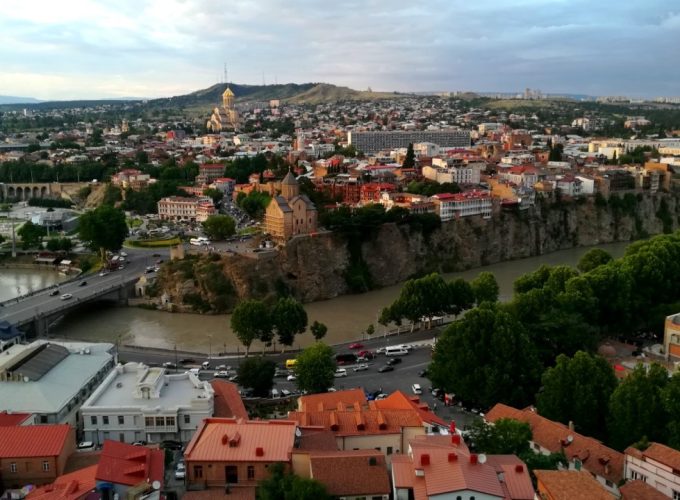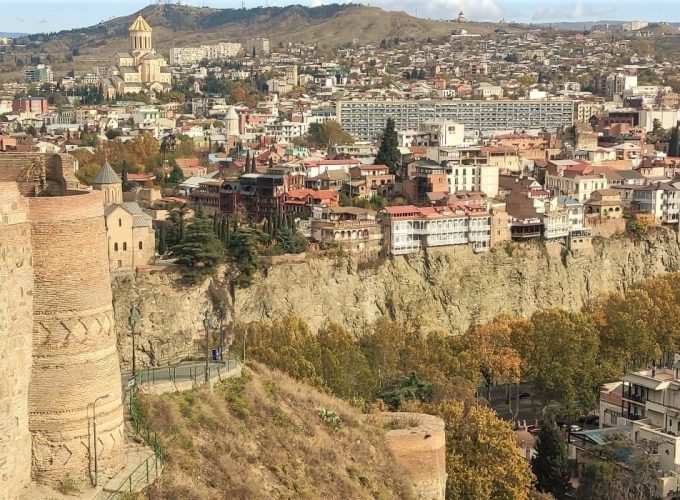The Sioni Cathedral, also known as Sioni Church of the Dormition, is a historic Georgian Orthodox cathedral located in the heart of Tbilisi, the capital of Georgia. It holds significant religious and cultural importance in Georgia and is one of the iconic landmarks of Tbilisi.
A Brief History of Sioni Cathedral
The origins of Sioni Cathedral trace back to the early centuries of Christianity in Georgia. The first church on this site is believed to have been built in the 6th or 7th century during the reign of King Vakhtang Gorgasali, the founder of Tbilisi. The original church suffered damage and destruction over the centuries due to various invasions and conflicts. The current cathedral, constructed in the 13th century, is the result of subsequent rebuilding efforts.
Sioni Cathedral exhibits a blend of architectural styles, including Georgian and Byzantine influences. Its exterior features brickwork and decorative elements, while the dome and bell tower are prominent architectural features.
The cathedral is dedicated to the Dormition of the Theotokos (the Virgin Mary), making it one of the most important religious sites in Georgia. It is home to the venerated icon of the Sioni Virgin Mary, which is believed to have miraculous properties.
Throughout its history, Sioni Cathedral has been a place of pilgrimage and worship for Georgian Orthodox Christians. It has played a pivotal role in the spiritual life of the country.
Sioni Cathedral has witnessed numerous historical events, including royal coronations, religious ceremonies, and important gatherings. It has also been a site of refuge during times of conflict and turmoil. Over the centuries, the cathedral has undergone several renovations and restorations to preserve its historical and cultural significance. These efforts have helped maintain the cathedral’s architectural and spiritual heritage.
Sioni Cathedral is not only a religious site but also a symbol of Georgia’s cultural heritage. Its architectural beauty and historical importance make it a prominent landmark in Tbilisi’s Old Town. Today, Sioni Cathedral is open to visitors and tourists. It is a popular destination for those interested in exploring the rich history of Tbilisi and experiencing the spiritual atmosphere of the cathedral.
Infrastructure around Abanotubani
- Metekhi Church: Located nearby, the Metekhi Church is another historic Georgian Orthodox church perched on a cliff overlooking the Kura River. It offers stunning views of the Old Town and the Narikala Fortress.
- Rike Park: Just a short walk from Sioni Cathedral, Rike Park is a modern green space along the Kura River. It features sculptures, fountains, and walking paths, making it a pleasant place for a leisurely stroll.
- Narikala Fortress: The ancient Narikala Fortress is a prominent landmark that can be seen from Sioni Cathedral. Visitors can hike up to the fortress to explore its medieval ruins and enjoy panoramic views of Tbilisi.
- Betlemi Street: Betlemi Street, with its historic architecture and charming atmosphere, is within walking distance of Sioni Cathedral. It’s a great place for shopping, dining, and exploring the Old Town.
- Meidan: Meidan Square, the bustling heart of Tbilisi’s Old Town, is a short walk from Sioni Cathedral. It’s surrounded by historic buildings, cafes, restaurants, and shops. The square often hosts cultural events and festivals.
- The Bridge of Peace: This iconic pedestrian bridge, designed by Italian architect Michele De Lucchi, spans the Kura River and connects Rike Park to the Metekhi area. The bridge’s unique design and LED lighting make it a notable attraction.
- Art Galleries and Studios: The Old Town, including the area around Sioni Cathedral, is home to various art galleries and studios. You may come across exhibitions and artistic expressions by local and international artists.
- Cafes and Restaurants: The vicinity of Sioni Cathedral offers numerous dining options where you can savor traditional Georgian cuisine, including khachapuri, khinkali, and local wines.
- Historic Buildings: The Old Town is known for its well-preserved historic buildings featuring a mix of Georgian, Persian, and other architectural influences. Many of these buildings have been converted into cafes, restaurants, and guesthouses.
How to get there
Getting to Sioni Cathedral in Tbilisi’s Old Town is relatively easy, as it is a central and well-known landmark in the city. Depending on your location within Tbilisi, you can use various transportation options:
- Walking: If you’re already in the city center or near the Old Town, walking is the most convenient way to reach Sioni Cathedral. The Old Town is pedestrian-friendly, and you can easily explore its historic streets on foot.
- Taxis: Taxis are readily available in Tbilisi, and you can either flag one down on the street or use ride-sharing apps like Bolt (formerly Taxify) or Yandex.Taxi. Simply tell the driver you want to go to “Sioni Cathedral” or “Sioni Church.”
- Public Transportation: Depending on your location, you can use public buses or the Tbilisi Metro to get closer to Sioni Cathedral. The nearest metro station is “Avlabari” on the Akhmeteli-Varketili Line (Line 2). From there, it’s a short walk to the cathedral.
- Minibuses (Marshrutkas): Marshrutkas are shared minibusses that operate on various routes throughout the city. You can inquire about a marshrutka heading to the Old Town or the Metekhi area, which is close to Sioni Cathedral.
Sioni Cathedral is a prominent and well-recognized landmark in Tbilisi, so many locals and taxi drivers should be familiar with its location. It’s a central part of the Old Town, making it relatively easy to find and access from various parts of the city.
Tours via the Sioni Cathedral
Useful Tips
When visiting Sioni Cathedral in Tbilisi, Georgia, here are some useful tips to enhance your experience and ensure a smooth and respectful visit:
- Dress Modestly: As a place of worship, it’s advisable to dress modestly when visiting Sioni Cathedral. Both men and women should cover their shoulders and knees. Women may want to carry a scarf or shawl to cover their heads if needed.
- Photography: Respect the rules regarding photography inside the cathedral. Some churches may prohibit photography or may allow it for personal use only. Always ask for permission if you’re unsure.
- Quiet and Respectful Behavior: Maintain a quiet and respectful demeanor while inside the cathedral. Remember that it is a place of worship, and many visitors may be engaged in prayer or reflection.
- Visit During Services: Consider attending a religious service if you’re interested in experiencing the cathedral’s spiritual atmosphere. Be sure to arrive early, dress appropriately, and participate respectfully.
- Respect for Religious Objects: Do not touch religious objects, icons, or decorations inside the cathedral unless you have received permission to do so.
- Language: While English may be spoken in tourist areas, learning a few basic Georgian phrases or using a translation app can be helpful for communication and may be appreciated by locals.
- Local Customs: Familiarize yourself with local customs and etiquette, such as the appropriate way to greet others and show respect in a religious setting
- Time Your Visit: If you prefer a quieter visit, consider visiting the cathedral during non-service hours to avoid the crowds.
By following these tips and being considerate of local customs and practices, you can have a respectful and enjoyable visit to Sioni Cathedral and gain a deeper appreciation for its historical and spiritual significance.
Baths District on a Map







Comment (0)